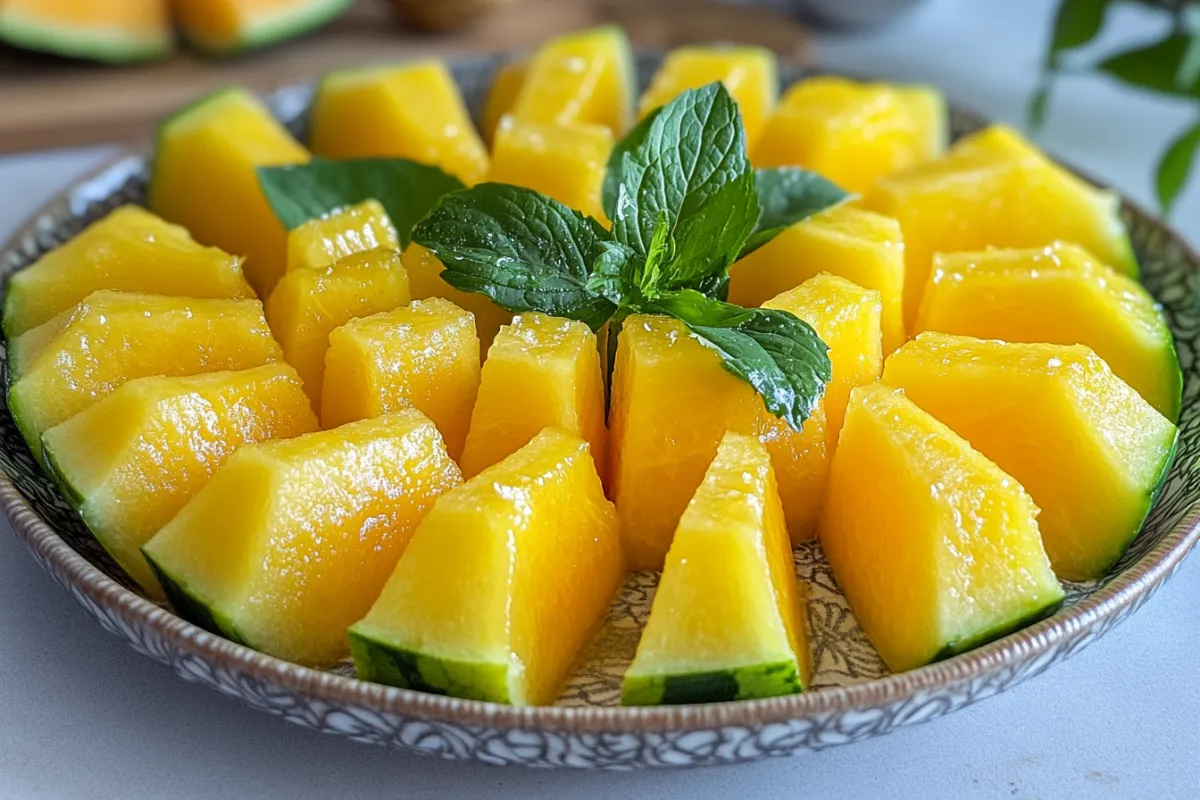What is the Difference Between Yellow and Pink Watermelon?
Watermelons are a summertime favorite enjoyed by many due to their juicy, sweet taste and hydrating properties. However, while most people are familiar with the traditional pink watermelon, there is another type that’s just as delicious—yellow watermelon. Both varieties share many similarities, yet they offer unique differences that make each one stand out. This article will thoroughly examine the difference between yellow and pink watermelon, including taste, nutritional content, health benefits, growing conditions, and much more. By the end, you will have all the information needed to decide which one fits your palate and dietary preferences.
1. A Brief History of Watermelons
Watermelons have a long history that dates back over 5,000 years. Originating in Africa, the fruit was initially cultivated for its high water content rather than for its sweetness. Early varieties of watermelon were much smaller and less sweet than what we enjoy today. Over time, the fruit spread to Europe, Asia, and eventually the Americas, where it became a popular summer treat.
In the modern era, watermelon breeding has led to the development of different varieties, including the pink/red watermelon that most people are familiar with, and the yellow watermelon, which is a slightly newer introduction.
- Pink Watermelon: The pink or red watermelon is the most common variety worldwide. Its flesh is colored by lycopene, a powerful antioxidant also found in tomatoes and other red fruits.
- Yellow Watermelon: On the other hand, yellow watermelons have existed for thousands of years as well, but they have gained popularity more recently. The yellow flesh is the result of the absence of lycopene and the presence of beta-carotene, another important antioxidant found in orange and yellow fruits like carrots.
In modern agricultural practices, both yellow and pink watermelons are grown using selective breeding techniques, and they are available in various regions across the world.
2. Key Differences Between Yellow and Pink Watermelons
When discussing the differences between yellow and pink watermelon, the first noticeable variation is the color of the flesh. However, their differences extend far beyond just appearance. Let’s break them down into various categories:
Visual Differences
- Pink Watermelon: The pink color is due to the presence of lycopene. The bright red or pink hue is often associated with ripeness and sweetness. This type of watermelon is what most people picture when they think of the fruit.
- Yellow Watermelon: The yellow color comes from beta-carotene, which gives the fruit a golden or yellow hue. This color difference is striking when the watermelon is sliced open and often surprises those who aren’t familiar with the yellow variety.
Taste Differences
- Pink Watermelon: Pink watermelon tends to have a more familiar sweet-tart taste due to the higher concentration of lycopene. It is typically described as refreshing with a balance between sweetness and tanginess.
- Yellow Watermelon: In contrast, yellow watermelon is generally sweeter and often has a honey-like flavor. This is due to the lower concentration of lycopene and higher levels of natural sugars. The flavor of yellow watermelon is also often described as more floral and delicate.
Texture
While the texture of both varieties is quite similar, some people describe yellow watermelon as slightly crisper than its pink counterpart.
Aroma
- Pink Watermelon: The aroma of pink watermelon is milder, with a refreshing fragrance.
- Yellow Watermelon: Yellow watermelon tends to have a stronger, more fragrant aroma that complements its sweeter taste.
Culinary Uses
Both yellow and pink watermelons can be used in a variety of ways in the kitchen:
- Pink Watermelon: It’s popular in salads, smoothies, fruit bowls, and as a refreshing snack.
- Yellow Watermelon: Due to its sweetness, yellow watermelon works well in desserts, salsas, and even as a grilled fruit option for a unique flavor twist.
3. Nutritional Comparison: Lycopene vs. Beta-Carotene
A key factor that differentiates yellow and pink watermelon is their nutrient content. While both are packed with vitamins and antioxidants, they differ in the type of antioxidant that dominates their profile.
Lycopene in Pink Watermelon
Lycopene is a plant nutrient with powerful antioxidant properties. It gives the pink watermelon its characteristic red color and has been widely studied for its health benefits. Lycopene is associated with:
- Heart Health: Studies show that lycopene can help lower cholesterol levels and improve heart health by reducing oxidative stress in the blood vessels.
- Cancer Prevention: Lycopene is also known for its cancer-fighting properties, particularly in reducing the risk of prostate cancer.
- Skin Protection: Lycopene is also known for protecting the skin from sun damage by acting as a natural sunscreen.
A single serving of pink watermelon contains around 6,000 micrograms of lycopene, making it a great option for anyone looking to boost their antioxidant intake.
Beta-Carotene in Yellow Watermelon
Yellow watermelon, on the other hand, is rich in beta-carotene, another potent antioxidant. Beta-carotene is what gives carrots, sweet potatoes, and pumpkins their vibrant orange hue. In the body, beta-carotene is converted into vitamin A, which is essential for:
- Vision Health: Vitamin A plays a key role in maintaining healthy eyesight and preventing conditions like night blindness.
- Immune Function: Vitamin A supports the immune system, helping the body fight off infections and diseases.
- Skin and Cell Growth: It is also vital for healthy skin and cell growth, making beta-carotene an excellent choice for those looking to improve their overall skin health.
Each serving of yellow watermelon contains approximately 3,500 micrograms of beta-carotene.
Hydration and Calorie Count
Regardless of color, both yellow and pink watermelons are composed of about 92% water, making them an excellent fruit for hydration, especially during hot weather. They are also low in calories—approximately 46 calories per cup—making them a guilt-free snack for anyone watching their weight.
Other Nutrients
Both varieties of watermelon are rich in vitamins A and C, potassium, and dietary fiber. These nutrients contribute to overall health by boosting the immune system, supporting skin health, and aiding in digestion.
4. Health Benefits of Watermelons
Whether you’re eating yellow or pink watermelon, the health benefits are plentiful. Watermelon, in general, is one of the most hydrating and nutrient-packed fruits available, offering a wide array of health advantages.
Hydration
Given that watermelon is composed of over 90% water, it is an excellent way to stay hydrated, particularly during summer months when dehydration is more likely. Staying properly hydrated is crucial for:
- Maintaining energy levels.
- Supporting metabolism.
- Promoting digestion and skin health.
Watermelon is often recommended as a post-exercise snack because it helps replace lost fluids and electrolytes.
Weight Loss Support
Thanks to its high water content and low-calorie count, watermelon is an ideal food for those looking to lose or maintain weight. The water and fiber in watermelon help you feel full without adding many calories to your diet.
Heart Health
Both pink and yellow watermelon contain nutrients that support heart health:
- Lycopene in Pink Watermelon: As mentioned earlier, lycopene helps to reduce bad cholesterol (LDL) and lower blood pressure, which can reduce the risk of heart disease.
- Beta-Carotene in Yellow Watermelon: Beta-carotene, along with its conversion into vitamin A, plays a role in reducing oxidative stress and inflammation, both of which contribute to cardiovascular health.
Anti-Inflammatory Properties
Watermelons contain cucurbitacin E, a plant compound with anti-inflammatory benefits. Reducing inflammation in the body is crucial for preventing chronic diseases like arthritis, heart disease, and even cancer. Both pink and yellow watermelons contain this beneficial compound.
Digestive Health
The fiber content in watermelon supports digestive health. While watermelon isn’t as high in fiber as some other fruits, its combination of fiber and water helps prevent constipation and promotes regular bowel movements.
Skin and Hair Benefits
The vitamins A and C found in watermelon contribute to skin and hair health. Vitamin C is essential for collagen production, a protein that keeps skin supple and hair strong. Vitamin A helps repair skin cells and can prevent dry, flaky skin.
Cancer Prevention
As antioxidants, both lycopene and beta-carotene play a role in protecting cells from oxidative damage that can lead to cancer. Lycopene, in particular, has been studied for its role in preventing prostate cancer, while beta-carotene has been linked to a reduced risk of lung cancer.
Eye Health
Thanks to the beta-carotene in yellow watermelon and vitamin C in both varieties, watermelon can help protect your eyes from age-related conditions such as macular degeneration and cataracts.
5. Culinary Uses: From Salads to Sorbets
Both yellow and pink watermelons are versatile in the kitchen, lending themselves to a variety of dishes. Here’s how you can use each variety:
Yellow Watermelon
- Salads: Add a sweet twist to your summer salad with cubes of yellow watermelon, paired with feta cheese, arugula, and a balsamic glaze.
- Salsas: Yellow watermelon adds a sweet note to spicy salsa when combined with jalapenos, lime juice, and cilantro.
- Grilled Watermelon: Grilling yellow watermelon brings out its natural sugars and creates a caramelized, sweet-savory dish perfect for summer barbecues.
- Sorbet: A refreshing yellow watermelon sorbet is a unique dessert that highlights the fruit’s honey-like flavor.
Pink Watermelon
- Fruit Bowls: Pink watermelon is a classic addition to fruit salads and bowls, mixed with berries, grapes, and mint.
- Smoothies: Blend pink watermelon with frozen berries and yogurt for a refreshing and hydrating smoothie.
- Cocktails: Pink watermelon pairs well with spirits like vodka and rum, making it a popular base for summer cocktails such as watermelon mojitos or margaritas.
- Gazpacho: Watermelon gazpacho is a cool, refreshing soup that combines the sweetness of watermelon with the tanginess of tomatoes and cucumbers.
For more creative ways to use watermelons, both yellow and pink, you can explore a variety of watermelon recipes in the ultimate guide to watermelons.
6. Frequently Asked Questions
Here are some common questions people ask when trying to decide between yellow and pink watermelons:
Does yellow watermelon taste the same as pink watermelon?
No, yellow watermelon is typically sweeter with a honey-like flavor, while pink watermelon has a more traditional watermelon taste with a balance of sweetness and tartness.
Why is some watermelon yellow inside?
Yellow watermelon lacks the lycopene that gives pink watermelon its color. Instead, it contains beta-carotene, which provides the yellow hue.
Is yellow watermelon genetically modified?
No, yellow watermelon is not genetically modified. It is a natural variety of watermelon that has been grown for centuries.
Which watermelon is healthier: yellow or pink?
Both yellow and pink watermelons offer health benefits. Yellow watermelon is rich in beta-carotene, which supports eye and skin health, while pink watermelon is high in lycopene, known for its heart health and cancer-preventing properties.
Where can I find yellow watermelon?
Yellow watermelon is often available at farmer’s markets and specialty grocery stores, particularly during the summer months.
7. Conclusion
When it comes to choosing between yellow and pink watermelon, it all boils down to personal preference and nutritional needs. If you enjoy a sweeter, honey-like flavor, yellow watermelon is the perfect choice for you. On the other hand, if you prefer the classic watermelon taste with a balance of sweet and tart, then pink watermelon is likely to satisfy your cravings.
Both varieties offer numerous health benefits, from hydrating your body to providing essential nutrients like beta-carotene and lycopene. Whether you’re eating them as a refreshing snack, using them in recipes, or even grilling them, you can’t go wrong with either type of watermelon.
For further reading and tips on the best ways to prepare watermelon dishes, explore more on the ultimate guide to watermelons.

